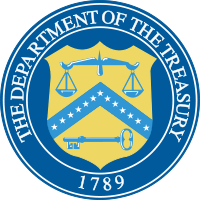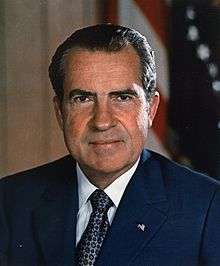David M. Kennedy
| David M. Kennedy | |
|---|---|
 | |
| 60th United States Secretary of the Treasury | |
|
In office January 22, 1969 – February 11, 1971 | |
| President | Richard Nixon |
| Preceded by | Joseph W. Barr |
| Succeeded by | John B. Connally |
| 8th United States Ambassador to NATO | |
|
In office March 17, 1972 – February 2, 1973 | |
| Appointed by | Richard Nixon |
| Preceded by | Robert Ellsworth |
| Succeeded by | Donald Rumsfeld |
| Personal details | |
| Born |
David Matthew Kennedy July 21, 1905 Randolph, Utah, United States |
| Died |
May 1, 1996 (aged 90) Salt Lake City, Utah, United States |
| Resting place | Randolph City Cemetery in Randolph, Utah, United States |
| Political party | Republican |
| Spouse(s) |
Lenora Bingham Kennedy (m. 1924 - 1995, her death) |
| Children |
Marilyn Kennedy Taylor Carol Kennedy Davis Barbara Kennedy Law Patricia Kennedy Campbell[1] |
| Alma mater |
Weber State University George Washington University Rutgers University |
| Profession | Politician |
| Religion | The Church of Jesus Christ of Latter-day Saints (Mormon) |
| Signature |
|
David Matthew Kennedy (July 21, 1905 – May 1, 1996), was an American politician and businessman. He served as the 60th Secretary of the Treasury and later as the 8th United States Permanent Representative to NATO, both under President Richard Nixon. He was Chief Executive and Chairman of the Board of Continental Illinois during the 1950s and 1960s.
Early life
Kennedy was born on July 21, 1905 in Randolph, Utah, to George and Katherine Kennedy (née Johnson). His father was a rancher and served in Utah state government. His mother was ill for much of his childhood and the family grew up in Kaysville and later Ogden. His grandparents John Kennedy and Peter Johnson formed the Bank of Randolph.
In November 1925, Kennedy married Lenora Margaret Bingham at the Salt Lake Temple and shortly thereafter served his mission in Liverpool, England. His mission presidents were James E. Talmage and John A. Widtsoe. [2]
Kennedy attended public schools and received his bachelor's degree from Weber State University, graduating in 1928. He obtained his first government job as a staff member for the Federal Reserve Board of Governors.[3] During this time he built up his financial experience and later became assistant to then-Fed Chairman Marriner Eccles. Kennedy was also attending George Washington University and received his master’s and law degree from there in 1935 and 1937. He completed his education at Rutgers’s Stonier Graduate School of Banking in 1939.
Chicago years
He left the Federal Reserve and joined Continental of Illinois in 1946, starting in their bond department. By 1951, he was a bank President and later served as Chairman of the Board and CEO from 1959 to 1969. At the time of his appointment in 1969, Continental Illinois ranked as the 15th largest bank in the world.
Kennedy served as counselor to John K. Edmunds in the presidency of the Chicago Stake of The Church of Jesus Christ of Latter-day Saints. He was also a member of the board of Nauvoo Restoration from its founding in 1962, and advised David O. McKay, Harold B. Lee and other LDS Church leaders on banking matters. It was in part due to the advice of Kennedy that McKay restructured the management of Zions First National Bank so that the president of the church no longer held the title of president of the bank, with Orval Adams assuming that title.[4]
During these same years, Kennedy also served as chairman of Mayor Richard J. Daley's Mayor's Committee for Economic and Cultural Growth in Chicago.[5] In 1957, Kennedy became a member of the Board of Trustees of the University of Chicago. While serving in this post, he was involved in fundraising. In 1966, he was asked to head a fundraising drive for Brigham Young University. He worked on this project until becoming Secretary of the US Treasury.[6]
From 1961 until January 1969, Kennedy was a member of the board of trustees of the Brookings Institution. In 1963, he commissioned a house in Winnetka, Illinois.[7]
Government service
Kennedy served as a special assistant on debt management to U.S. Secretary of the Treasury George M. Humphrey. He also served on the staff of the Board of Governors of the Federal Reserve system from 1930 to 1946,[8] ending up assistant to the Chairman.
In October 1962, President John F. Kennedy (no relation) appointed him a member of a private corporation (COMSAT) to own and operate the United States' share of a global satellite communications system. He was elected to the permanent board of directors in 1964.[9]
President Lyndon B. Johnson in 1969 appointed him chairman of the Commission on Budgetary Concepts, whose recommendations were adopted as standard government budgetary practice.
Kennedy was nominated by President Richard Nixon to be the 60th Secretary of the Treasury. He served from 1969 until 1971.
Kennedy served as the U.S. Ambassador to NATO from March 1972 to February 1973.
He founded the US-Taiwan Business Council in 1976, and served as its Chairman for fourteen years, until 1990.
Church service
He also served as a special representative of the First Presidency of The Church of Jesus Christ of Latter-day Saints.[10] This assignment required him to represent the church around the world, meeting with government and ecclesiastical leaders.
In 1985, the David M. Kennedy Center for International Studies at Brigham Young University opened and is named in his honor.
Kennedy died in Salt Lake City, Utah on May 1, 1996, from cardiovascular disease and the congestive heart failure, at the age of 90. Followed to death of his wife, Lenora Bingham, on August 24, 1995. He was interred in Randolph City Cemetery, near to his birthplace in Randolph, Utah.
References
- ↑ M. Dallas Burnett (June 1986). "David M. Kennedy: Ambassador for the Kingdom". Ensign. Retrieved 2015-06-23.
- ↑ Palmer, Spencer J., The Expanding Church, (Salt Lake City: Deseret Book, 1978) p. 65
- ↑ Sobel, Robert. Biographical Dictionary of the United States Executive Branch, 1774-1977, (Westport: Greenwood Press, 1977) p. 199-200
- ↑ Hickman 1987, pp. 206–207
- ↑ Hickman 1987, p. 211
- ↑ Hickman 1987, pp. 213–215
- ↑ Hickman 1987, pp. 215–216
- ↑ Sobel, Robert. Biographical Dictionary of the United States Executive Branch, 1774-1977, (Westport: Greenwood Press, 1977) p. 199-200
- ↑ "Stockholders Back COMSAT Management". St. Petersburg Times, Sept. 18, 1964. Retrieved 17 May 2009.
- ↑ "Who Is David M. Kennedy". About Us. David Kennedy Center for International Studies. Retrieved 2015-06-23.
Biography
- Hickman, Martin Berkeley (1987), David Matthew Kennedy: Banker, Statesman, Churchman, Deseret Book Co., in cooperation with the David M. Kennedy Center for International Studies, ISBN 0-87579-093-3
External links
- David M. Kennedy Center for International Studies
- Funeral of David M. Kennedy
- David Matthew Kennedy papers, MSS 1583 at L. Tom Perry Special Collections, Brigham Young University
| Diplomatic posts | ||
|---|---|---|
| Preceded by Robert Ellsworth |
United States Permanent Representative to NATO 1972 – 1973 |
Succeeded by Donald Rumsfeld |
| Political offices | ||
| Preceded by Joseph W. Barr |
U.S. Secretary of the Treasury Served under: Richard Nixon 1969–1971 |
Succeeded by John Connally |

